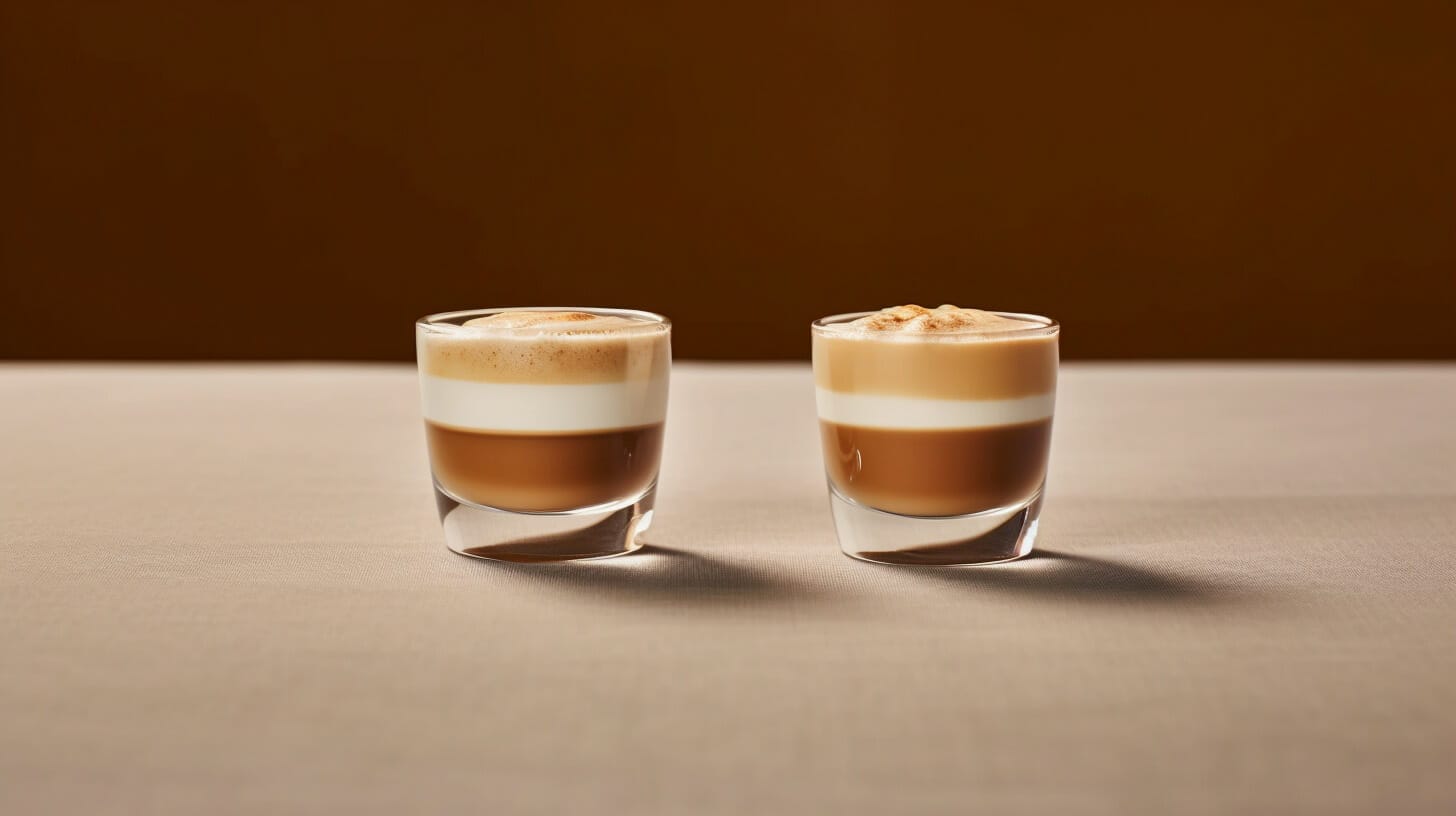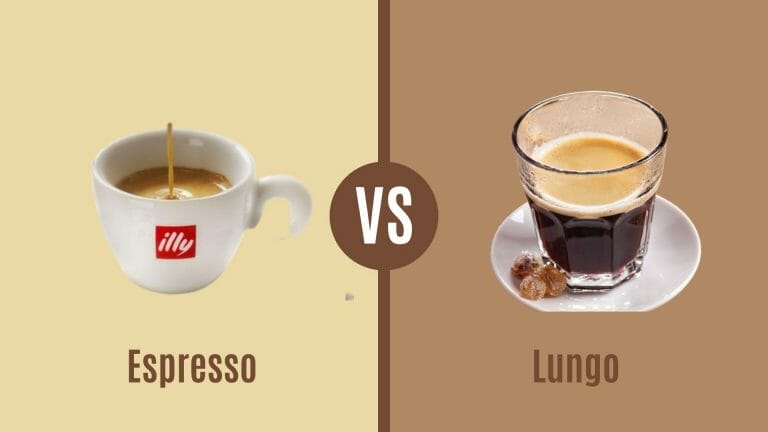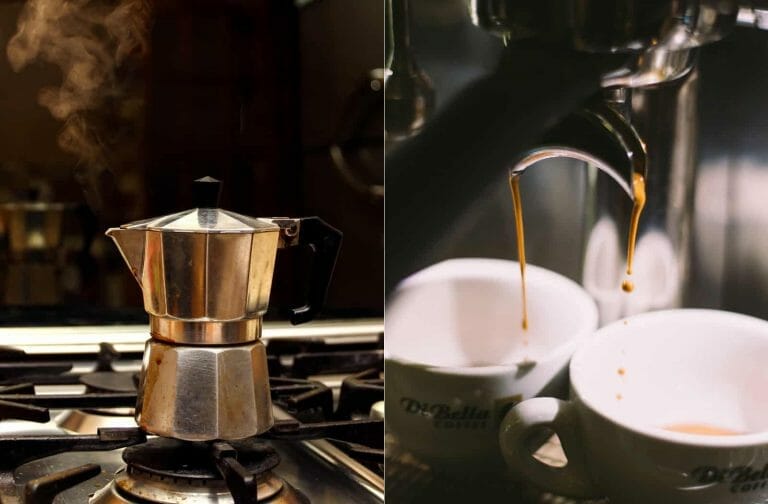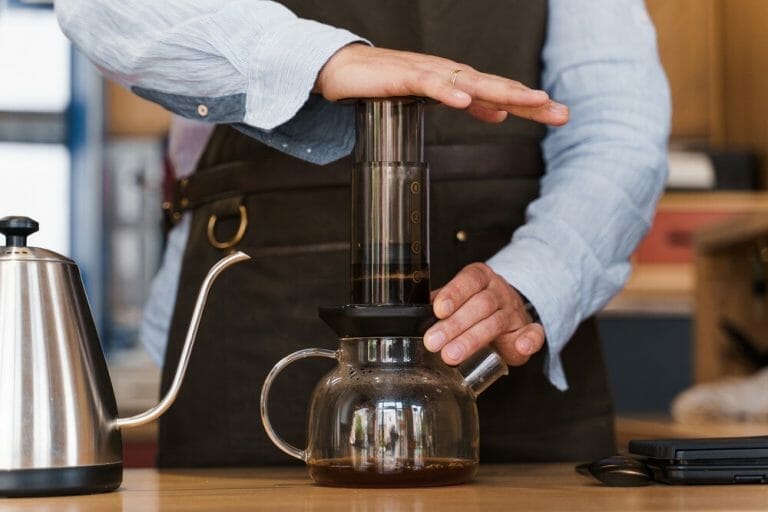Espresso Vs Macchiato: The Ultimate Coffee Showdown

You might be wondering which is better for you: an espresso or a macchiato. Well, it all depends on your taste preferences and the occasion.
The milk debate is at the heart of this dilemma, as espressos are typically served black while macchiatos have a dollop of steamed milk on top.
The origin stories of these two drinks are also quite different.
Espresso originated in Italy in the early 20th century, while macchiato comes from the Italian word ‘stained’ and was first made in France.
Both drinks have evolved over time with popular variations like iced versions and specialty ingredients such as flavored syrups.
Barista techniques also vary between the two drinks, with latte art being more commonly found in macchiatos due to their milk topping. Ultimately, it’s up to you to decide which one suits your taste buds best!
Key Takeaways
- Espresso and macchiato are two popular Italian coffee drinks with distinct taste profiles and serving sizes.
- Espresso is a concentrated shot of coffee with a complex flavor profile, while macchiato is made by adding a small amount of milk foam on top of an espresso shot.
- The choice between these drinks comes down to personal taste preferences and desired level of caffeine intake.
- Proper milk steaming techniques are important in creating a velvety texture and balanced flavor profile in espresso-based beverages.
The Coffee Connoisseur’s Guide: An In-Depth Comparison of Espresso Vs Macchiato
| Parameter | Espresso | Macchiato |
|---|---|---|
| Origin | Italy | Italy |
| Meaning | “Express” or “Fast” | “Stained” or “Spotted” |
| Description | A concentrated form of coffee served in “shots”. | Espresso with a small dollop of milk. |
| Brewing Process | Brewed by forcing hot water through finely-ground coffee under high pressure. | Starts with a shot of espresso ‘stained’ with a small amount of frothed milk. |
| Components | Espresso is pure coffee with no added ingredients. | Espresso forms the base with a splash of milk to form the macchiato. |
| Taste | Bold, rich, and concentrated with a layer of crema on top. | Similar to espresso, but slightly milder and creamier due to the addition of milk. |
| Texture | Dense and viscous due to the concentrated coffee. | Creamier and smoother due to the addition of milk. |
| Volume | Typically 30ml (1 fluid ounce) for a single shot. | Same as espresso, plus a few teaspoons of frothed milk. |
| Caffeine Content | Approximately 63mg per shot. | Similar to espresso, as the addition of milk does not significantly alter the caffeine content. |
| Calories | Approximately 5 calories per shot. | Slightly more than espresso due to the addition of milk, but still under 20 calories. |
| Serving Style | Typically served in a small, thick-walled cup. | Usually served in a glass to display the ‘stain’ of milk. |
| Best Enjoyed | Anytime for a quick caffeine fix, especially in the morning. | Ideal for the afternoon or for those who prefer a milder taste. |
| Home Brewing | Requires an espresso machine and finely-ground coffee. | In addition to the espresso requirements, you’ll need milk and a tool to froth it. |
The Espresso Story: Concentration Meets Intensity
Combining the perfect balance of strength and richness, the concentrated flavor of an espresso shot is a true testament to the art of coffee-making.
Here are three interesting facts about it:
- Espresso originated in Italy in the early 20th century, where it was invented as a way to quickly serve coffee to busy customers.
- The brewing process involves forcing hot water through finely ground coffee beans at high pressure, resulting in a small but potent shot with a complex flavor profile.
- Espresso shots can be enjoyed on their own or used as a base for popular variations such as cappuccinos and lattes.
The concentration vs intensity debate is often brought up when discussing espresso versus other coffee drinks like macchiato.
While both involve concentrated shots of coffee, espresso’s unique brewing method creates an intense flavor that sets it apart from other drinks.
Its origins and history also add cultural significance to its popularity around the world, making it an enduring favorite among coffee lovers everywhere.
The Macchiato Tale: Espresso with a ‘Mark’
Now let’s delve into the story of how this Italian beverage with a ‘mark’ came to be – the macchiato.
This espresso variation is made by adding a small amount of milk foam on top of your shot, creating an artful and delightful contrast in both taste and appearance.
Milk steaming is crucial for making a great macchiato, as you need just the right amount of foam to create that perfect mark.
This is why barista tips are important when it comes to crafting this drink – they can teach you how to get the right consistency and texture so that you can achieve that beautiful latte art on top.
The macchiato has become a staple in coffee culture, showcasing not only the skill of the barista but also allowing customers to have more control over their espresso experience.
Behind the Brew: The Espresso Process
Get ready to learn about the fascinating process behind brewing one of your favorite coffee beverages – espresso!
It all starts with the selection of high-quality beans that are roasted to perfection. Once the beans are selected, they are ground into a fine powder and packed tightly into a portafilter.
This is where the magic happens!
As hot water is forced through the compacted grounds, it extracts the rich and flavorful oils from the beans.
The extraction time is crucial in determining the taste and quality of espresso. Typically, it takes between 20-30 seconds for water to pass through a single shot of espresso.
During this time, a creamy layer called crema forms on top of the drink due to emulsification of oils and air bubbles.
Proper milk steaming techniques also play an important role in creating a velvety texture and balanced flavor profile in your espresso-based beverages.
| Espresso Process | Description |
|---|---|
| Bean Selection | High-quality beans that are roasted to perfection |
| Extraction Time | Takes between 20-30 seconds for water to pass through a single shot |
| Crema Formation | A creamy layer called crema forms on top due to emulsification |
| Milk Steaming Techniques | Play an important role in creating a velvety texture and balanced flavor profile |
So next time you take a sip of your perfectly crafted latte or cappuccino, remember all of the hard work that went into making that delicious shot of espresso!
I apologize for the confusion. Here’s the properly formatted table:
Balancing the Act: The Macchiato Method
Balancing flavors can be tricky, but the macchiato method has found a way to do it perfectly.
Unlike an espresso shot served straight up, the macchiato has a dollop of milk foam artfully added to balance out the bitter espresso taste.
The technique tips for making this drink are simple yet essential: start by pulling an espresso shot, then steam your milk until it’s nice and frothy.
Next, spoon the milk foam onto the espresso shot in a creative pattern, ensuring that it’s not too much or too little.
Milk pairing is crucial when making a macchiato, as it must complement rather than overpower the rich coffee flavor.
A good rule of thumb is using whole milk, as its creamy texture balances well with the intense espresso taste.
The serving size of this drink is also smaller than your average latte or cappuccino, typically served in a 2-3 ounce demitasse cup, perfect for those who want their caffeine fix without feeling overwhelmed by excessive amounts of milk.
The key to perfecting this drink lies in finding the right flavor balance between coffee and milk.
Once you’ve mastered this, you can get creative with your foam art designs and impress your guests with every sip they take!
Flavour Fight: Espresso and Macchiato Taste Profiles
The taste profiles of these two bold coffee beverages are like a flavorful duel, with one bringing intense bitterness and the other offering balance through frothy milk.
The espresso is known for its rich, full-bodied flavor that packs a punch with every sip. Its aroma is strong and pungent, while its mouthfeel is thick and heavy.
The aftertaste lingers on the tongue, leaving a bitter taste that can be both delightful or overwhelming depending on one’s preference.
On the other hand, the macchiato provides a contrasting flavor experience by adding frothy milk to cut through the bitterness of the espresso shot.
This blend offers a creamy texture and mild sweetness that balances out the intensity of the coffee.
When doing a flavour comparison between these two drinks in a taste test, it’s clear that they have distinct profiles based on their aroma analysis, mouthfeel examination, and aftertaste evaluation.
Ultimately, which one you prefer comes down to your personal taste preferences – whether you enjoy bold flavors or prefer something more balanced and mellowed out with milk.
Calorie and Caffeine Showdown: Espresso Vs Macchiato
You’ll be surprised to know the calorie and caffeine differences between these two coffee contenders.
While espresso is known for its strong caffeine kick, it actually has fewer calories than a macchiato.
A single shot of espresso only contains about 3-5 calories, while a macchiato can range from 70-200 calories depending on how it is prepared.
But don’t let the calorie count fool you – both drinks can provide nutritional value and health benefits.
Espresso has been linked to improved cognitive function and lower risk of heart disease, while milk-based macchiatos offer calcium and vitamin D.
Ultimately, the choice between these drinks comes down to personal taste preferences and desired level of caffeine intake.
Check out this table below for a quick comparison of their calorie and caffeine content:
| Coffee Type | Calorie Count | Caffeine Content |
|---|---|---|
| Espresso (1 shot) | 3-5 calories | 63 mg |
| Macchiato (8 oz) | 70-200 calories | 71 mg |
So next time you’re deciding between an espresso or a macchiato, consider not just their taste but also their nutritional benefits and effects on your daily caloric intake.
Whether you choose to indulge in a creamy macchiato or opt for a simple espresso shot, both options have something unique to offer for your morning pick-me-up.
Best Brew Times: Espresso and Macchiato Moments
When it comes to enjoying your morning coffee, the best brew times for getting the most out of your espresso or macchiato are all about finding those perfect moments for savoring each sip.
To achieve that, you need to pay attention to the brewing techniques of each drink.
Espresso is brewed by forcing hot water through finely ground coffee beans under high pressure, resulting in a concentrated shot with a rich crema on top.
On the other hand, macchiato is made by adding a small amount of steamed milk to an espresso shot, creating a layered drink with bold flavor notes.
Serving sizes also play a role in determining the best time to enjoy these drinks. Espresso shots are typically served in small demitasse cups and are meant to be consumed quickly while still hot.
In contrast, macchiatos come in larger sizes and can be enjoyed more leisurely due to their added milk component.
Milk choices can also affect how and when you enjoy your macchiato – whether you prefer whole milk for creaminess or non-dairy options for dietary reasons.
Knowing the origin stories of these drinks can add another layer of appreciation to your coffee experience as well.
DIY Brews: Home Espresso and Macchiato Guides
For those looking to elevate their coffee game at home, try your hand at crafting these classic Italian drinks with our easy-to-follow guides.
Home brewing has never been easier with the right equipment essentials. You’ll need a reliable espresso machine and a milk frother to create the perfect macchiato or espresso shot.
Choose quality beans that suit your taste preferences for a truly personalized experience.
Once you have all the necessary tools, it’s time to get started on your masterpiece.
Begin by preparing your espresso shot using freshly ground beans and hot water.
Then, steam and froth your milk until it reaches the desired texture and temperature. Finally, combine the two components in a small cup, creating beautiful latte art if desired.
With these simple steps, you can enjoy a delicious macchiato or espresso anytime from the comfort of your own home!
FAQs
Espresso Vs Macchiato: The Verdict
Indulging in a rich, creamy coffee experience can be the perfect indulgence for any coffee lover.
When it comes to choosing between espresso and macchiato, it all boils down to your personal taste preferences.
Espresso is known for its intense flavor and concentrated caffeine content. Its popularity has grown worldwide due to its strong flavor and versatility in crafting various coffee drinks.
Espresso shots are typically served in small quantities of 1-2 ounces with origins dating back to Italy in the early 20th century.
On the other hand, macchiato’s origin story is unclear, but this drink has become popular among those who enjoy a little milk in their espresso shot.
With variations like caramel or vanilla macchiatos becoming more mainstream, there’s no doubt that both espresso and macchiato have earned their place as beloved coffee choices around the world.





